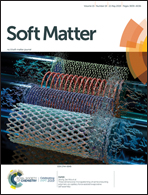Adhesive elastocapillary force on a cantilever beam†
Abstract
This paper reports an experimental and theoretical investigation of a cantilever beam in contact with an underlying substrate, in the presence of an intervening liquid bridge. The beam is deflected in response to the adhesive capillary forces generated by the liquid. Three main regimes of contact are observed, similarly to other elastocapillary systems already reported in the literature. We measured both the position of the liquid meniscus and the force at the beam clamp in the direction normal to the substrate, as functions of the distance between the beam clamp and the substrate. The resulting force–displacement curve is not monotonic and it exhibits hysteresis in the second regime that we could attribute to solid–solid friction at the beam tip. In the third regime, the adhesive force measured at the clamp strongly increases as the beam approaches the substrate. A 2-dimensional beam model is proposed to rationalize these measurements. This model involves several non-linearities due to geometrical constraints, and its solution with a minimum of iterations is not trivial. The model correctly reproduces the force–displacement curve under two conditions: friction is considered in the second regime, and the reaction force applied by the substrate on the beam is distributed in the third regime. These results are discussed in the context of the adhesion of setal tips involved in the terrestrial locomotion of beetles.



 Please wait while we load your content...
Please wait while we load your content...